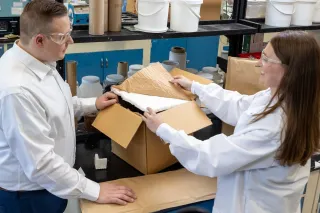In December 2023, the SmartRecovery project gave us a unique opportunity to embark on a journey to Lund, Sweden to visit the MAX IV laboratory to give us a better understanding of lignin.
The SmartRecovery project is a collaborative research initiative between VTT Technical Research Centre of Finland and Aalto University, supported by industry partners. The project aims to support Finnish industries in the shift to bio-based solutions by enabling lignin commercialization and market entry of new lignin-based products. Lignin, a by-product of pulping, has traditionally been burned for its high heating value, but its potential in the market is much more versatile. An integral part of this Business Finland funded project is the development of a novel approach to recover lignin from biorefinery side streams with a defined morphology, which is expected to improve its applicability in various products like coatings and energy storage applications. This initiative is part of the broader goal to replace fossil materials with biobased alternatives, addressing global challenges such as climate change, resource depletion, and waste management.
The SmartRecovery project team heading to Lund comprised of seven enthusiastic scientists, Patrik Ahvenainen and Paavo Penttilä from Aalto University, Miriam Kellock, Stefania Bertella and Jonathan Berg from VTT and Olesya Fearon and Risto Hänninen from Fortum Bio2x, united by our curiosity and the shared goal of pushing the boundaries of knowledge. At this time of the year the cold winds of Lund carry with them the promise of scientific discovery as we embarked on a fascinating journey to the MAX IV Laboratory, a beacon of cutting-edge research and innovation. Our mission: to make the invisible visible by unlocking the secrets of lignin on a minuscule scale.

How to make the invisible visible
The first day at MAX IV we were greeted by the by the facility's experienced staff. As we familiarized ourselves with the ways of working at MAX IV, lab protocols, and safety instructions, we were also given first row tickets to learn about the synchrotron radiation process—a beam of light produced by electrons moving at nearly the speed of light. This beam, of X-rays, would become our tool for making the invisible in lignin visible.
Our standout memory was the experimental session at the CoSAXS beamline, which is a state-of-the-art multipurpose Small Angle X-ray Scattering (SAXS) instrument. We dedicated most of our time to the facilities designated for this beamline, where we worked tirelessly in shifts to collect comprehensive data for our future research endeavors. Like every journey, ours had its highs and lows. Despite encountering a few obstacles along the way, we prevailed thanks to the invaluable assistance of the beamline crew, especially Pablo Mota-Santiago and Tomás Plivelic. In addition, a special acknowledgement to the well-equipped vending machines with 24/7 food service getting us through the evening and night shifts!
After an intense 24-hour period of nonstop runs, we were satisfied with the collected data and look forward to analyzing the results back in Finland. By tracking changes in particle size, shape, and arrangement over time, in situ SAXS gives us important information about how lignin particles form. This understanding is key to improving the properties and performance of materials based on lignin. Moreover, using in situ SAXS to study lignin particle formation not only improves our understanding of how lignin self-assembles, but also helps us design lignin-based materials with specific features and uses.
When reflecting back on our journey it has become evident that MAX IV isn’t just a hub for scientific inquiry; it is a demonstration of human curiosity and the relentless pursuit of understanding. The collaborative atmosphere, coupled with the cutting-edge technology, created an environment where discoveries seemed inevitable. As we exited MAX IV, it had not only expanded our understanding of lignin but had also fueled our passion for pushing the boundaries of knowledge.





